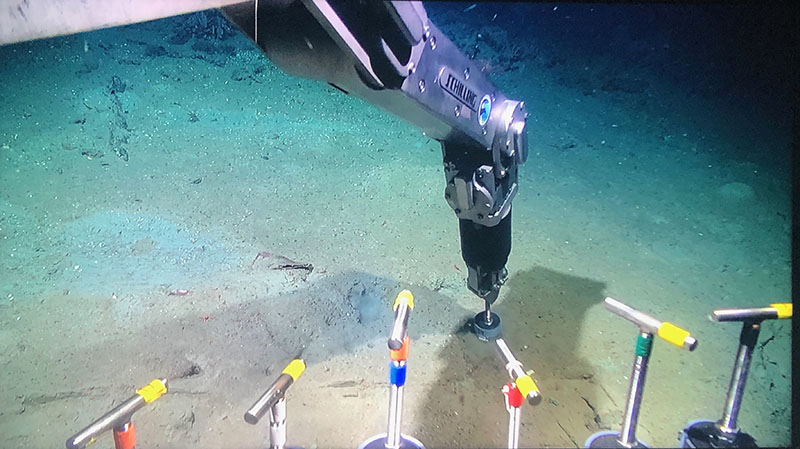
By Dr. Justyna Hampel, Post Doctoral Research Associate, School of Ocean Science and Engineering, University of Southern Mississippi
June 30, 2019
This is my first research cruise and my first time sampling marine sediments. Coming from shallow freshwater lake research, I know I had A LOT to learn. However, I am learning far more than just the science of marine sediments. It never occurred to me how much engineering and building goes into oceanography. When doing science at sea, it is critical to come up with fast solutions and be able to replace or rebuild parts and equipment that break. There is no way of going back to shore to get things fixed, unless we absolutely need to. During this expedition, I learned how to use various tools, build structures from PVC, and “MacGyver” things out of random objects. “Microbial Stowaways” is a collaborative project, where archaeology meets marine microbial ecology and machine learning. It is fascinating to work with marine archeologists and watch them survey unknown shipwrecks. We also have geologists aboard, so I am learning so much about these different disciplines simply by having a nice chat during lunch or dinner.

ROV Odysseus taking a sediment sample with a push core. Image captured by ROV Odysseus, courtesy of Microbial Stowaways. Download larger version (jpg, 2.5 MB).
The focus of my research is to see how shipwrecks change the microbial communities (the microbiome) on the seafloor, specifically in sediments. To achieve that, we must first collect sediment cores with a help of a remotely operated vehicle (ROV). This can get a little tricky because the ROV crew controls the ROV while aboard R/V Point Sur, while the ROV is 500 - 1,800 meters (~1,640 - ~5,905 feet) below the surface.
Once the cores make it back to the ship, we start the sample process. Some of the cores get sliced in four-centimeter increments for DNA analysis, while some of the others are left intact for geochemical pore water analysis. During this processing stage, mud usually gets everywhere and on everything: floor, countertops, ceiling (sometimes), and scientists. Usually mud processing has to happen fairly quickly, so we have all hands on the cores and get help from every member of our scientific party. I am very grateful for that.

Early morning CTD sampling for DNA and nutrients in the water column. Image courtesy of Microbial Stowaways. Download larger version (jpg, 4.8 MB).

Set-up for sediment pore water geochemical analysis aboard R/V Point Sur. Image courtesy of Microbial Stowaways. Download larger version (jpg, 5 MB).
The deep sea is a truly magical place, full of mysterious shipwrecks, weird-looking sea cucumbers, and deep-sea Lophelia coral. Aboard the ship, we were fortunate to watch dolphins, sharks, and many different fish. On top of all that, we have a wonderful crew to sail with, the food is amazing, and I feel incredibly lucky to be here on this project. It isn’t always easy. We work long hours processing samples and ensuring everything is ready for the next day and another ROV dive. But it feels great to be out here, doing awesome science with great people. Once we get back to shore, I cannot wait to start extracting and sequencing mud DNA to find out more about mud microbiomes and the impact of shipwrecks on microbial marine life.